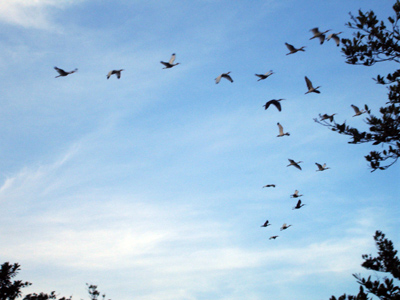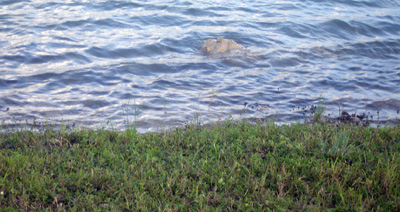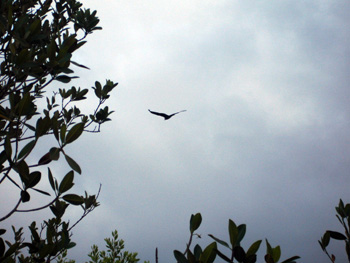
ORVs help visitors see best of Big Cypress
OCHOPEE, Fla.— A mixture of 30-foot pines and mangrove forests submersed in seasonal rains constitute Big Cypress National Preserve.
While most of the 729,000 acres in the preserve are nearly impossible to reach by foot the use of off-road vehicles is not only a means of transportation in the park, it’s an exploration.
The seemingly undiscovered lush prairies and swamp lands appear to lack any trace of human existence. Wild birds call to each other from the tops of trees while wild preys evade their hunter counterparts. Alligators, bears and deer play out their roles in this untamed and dangerous ecosystem.
 |
A flock of ibis flies over the Big Cypress National Preserve (Photo by Ali Bustamante). |
“Everyone and everything has its own role in this ecosystem,” Bridget Bellsy, an Everglades National Park and Big Cypress National Preserve ranger, stated. “We have to make sure the animals do their jobs as much as we have to make sure we do ours.”
Navigating slowly through the hardwoods and cypress strands offers the best observation of species in their tropical habitat. Coasting on the muddy trails at about 10 miles per hour on first gear eliminates the engine noise that would scare off wildlife.
Bear Island and Burns Lake, located on the western most point of the preserve, offer off-road trails with some of the best visibility of alligators and bears. While animals may become uncomfortably too close to the car, a honk of the horn usually scares them away.
“Watch out for the deer,” Cathy Tearle, a Homestead resident and Sierra club member, warned me before driving into the gravel trail.
I waived her goodbye and began my journey. I anticipated the main attraction of wildlife watching, the illusive Florida panther. The preserve is home to about 30 Florida panthers that are protected as an endangered species.
Approximately 25 miles from the U.S. 41 Visitor Center, the trail is set aside for specific use of all terrain vehicles as well as 4 by 4 vehicles. The trail leads back to I-75 as well as to the Bear Island campsite.
The Bear Island campsite serves as a perfect setting for a picnic as it offers a lake view backdrop and an array of flowering plants in bloom. Proper supplies and water must be packed beforehand as bathrooms and running water are non existence.
“This area is the hidden secret of the preserve,” Leonard Villa, a Naples resident who visits Bear Island five times a year, stated. “It’s hard to get to but the views are awesome.”
The biological diversity of wildlife and plant life is a staple of Big Cypress as much as the amount of mosquitoes is. Unfortunately, the wet season’s humidity and high temperatures attract even more mosquitoes to the point that they may become intolerable for some so it is necessary to protect skin with repellant.
While I didn’t dare to roll the windows down caution must be taken into account whenever stepping out the vehicle because although the animals may not be seen that is not indicative that they are not there.
Through hundreds of years of adaptation animals successfully camouflage themselves with their surroundings. “Snakes and alligators are the biggest threats,” Bridget stated. “Most incidents could’ve been prevented with a little more caution”
 |
Alligator peeks head above lake along Bear Island (Photo by Ali Bustamante). |
Some wildlife such as alligators are also affected by the wet season as they tend to keep most of their bodies under water for the exception of their eyes and nostrils. Bears, on the other hand, seek caves in search of cooler temperatures.
“The birds are great but where are rest of animals,” Valerie Tablada, questioned. My companion had become restless after an hour of driving around the scenic swamps.
Rain can damper wildlife watching so it’s best to take a look at a forecast before scheduling your next visit. Before embarking on an off-road exploration it is also necessary to obtain an off-road vehicle permit from the Visitor Center and pack meals, sanitary items and safety necessities.
If You Go
- The Big Cypress National Preserve is west of Miami on U.S. 41 (also known as Tamiami Trail).
- Telephone: 239-695-1201 There are no park entrance fees.
- Big Cypress Visitor Center at Oasis, open: 9 a.m. to 4:30 p.m. Closed Dec. 25.
- Location: On U.S. 41, Tamiami Trail, approximately half-way between Naples and Miami.
- Camping on Bear Island: Open All Year: Campgrounds may close seasonally or temporarily for repairs or resource concerns. Please contact the visitor center for current campground information. Make a right out of the Oasis Visitor Center onto the Tamiami Trail. Make a right up Turner River Road (S.R. 839), which turns into a dirt road for about 20 miles. Make a right into the Bear Island Campground.
- Off Road Vehicles: Permit Office located at Oasis Visitor Center, $50 annual vehicle permit. ORV inspection times are Fridays, Saturdays, Sundays, and Mondays. 8:30 a.m. to 3 p.m.
| A southeastern American kestrel falcon flies over Big Cypress National Preserve (Photo by Ali Bustamante). | 
|

Comments are Closed